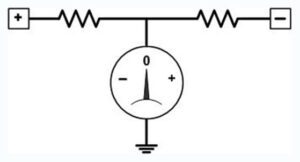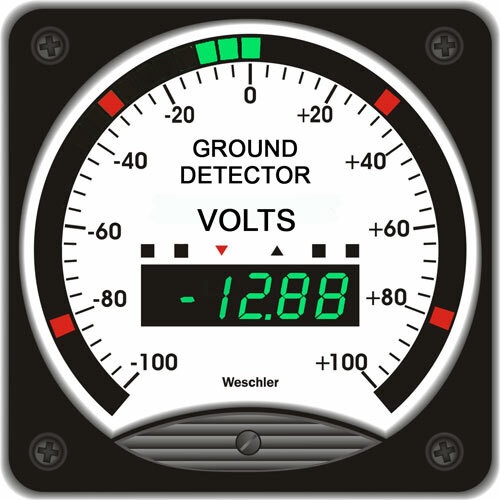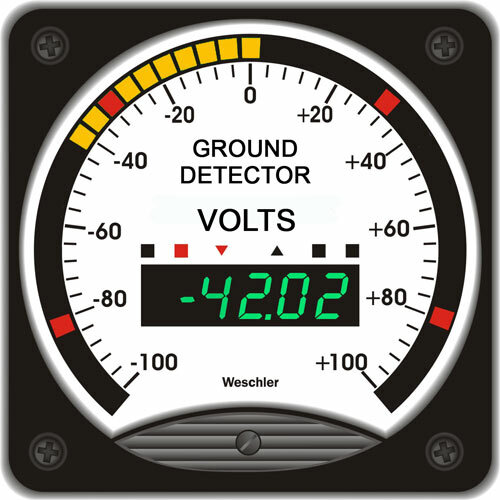 A ground detection voltmeter is used to monitor a floating battery bank for inadvertent grounding on either side. Historically, a center zero analog meter has been used for this application. The meter typically has a 250μA, 500μA, or 1mA DC movement, with a voltage scale of 100-0-100 for a 72V battery bank, 150-0-150 for a 125V battery bank or 300-0-300 for a 250V battery bank. Two high-value resistors are installed across the battery and the center tap is connected to the grounded meter. A low impedance to ground on either side of the battery causes the meter to move off center, indicating both the severity of the fault and which side it is on. The resistor value is selected so that with a direct short to ground, the meter reads the full battery voltage. A meter with a 500μA input and 150-0-150 volt scale would connect to 300kΩ resistors. The same input and a 300-0-300 scale would use 600kΩ resistors.
A ground detection voltmeter is used to monitor a floating battery bank for inadvertent grounding on either side. Historically, a center zero analog meter has been used for this application. The meter typically has a 250μA, 500μA, or 1mA DC movement, with a voltage scale of 100-0-100 for a 72V battery bank, 150-0-150 for a 125V battery bank or 300-0-300 for a 250V battery bank. Two high-value resistors are installed across the battery and the center tap is connected to the grounded meter. A low impedance to ground on either side of the battery causes the meter to move off center, indicating both the severity of the fault and which side it is on. The resistor value is selected so that with a direct short to ground, the meter reads the full battery voltage. A meter with a 500μA input and 150-0-150 volt scale would connect to 300kΩ resistors. The same input and a 300-0-300 scale would use 600kΩ resistors.
 A digital meter will easily replace the analog meter in this circuit, often mounting in the same panel cutout. A digital bar graph meter provides both a digital readout and a highly visible bar to indicate a fault condition. A standard Weschler BarGraph meter has a single-color bar. To help an operator spot a problem more quickly, a tri-color BarGraph meter can be configured to change the bar color when a user-defined threshold level is exceeded in either direction. In the first photo, the green bar indicates an acceptable level of leakage. In the second photo, the yellow bar highlights a leakage above the first threshold level (shown in red). Models with a circular bar are typically used in this application. BarGraph meters with a straight bar can also perform this function.
A digital meter will easily replace the analog meter in this circuit, often mounting in the same panel cutout. A digital bar graph meter provides both a digital readout and a highly visible bar to indicate a fault condition. A standard Weschler BarGraph meter has a single-color bar. To help an operator spot a problem more quickly, a tri-color BarGraph meter can be configured to change the bar color when a user-defined threshold level is exceeded in either direction. In the first photo, the green bar indicates an acceptable level of leakage. In the second photo, the yellow bar highlights a leakage above the first threshold level (shown in red). Models with a circular bar are typically used in this application. BarGraph meters with a straight bar can also perform this function.
 A digital meter offers several other improvements over an analog meter. Relay outputs can be included to activate an external alarm at each fault level. Analog output is available to transmit a process-level signal to a remote device for display, recording or alarming. A digital interface allows remote monitoring through a network or SCADA system.
A digital meter offers several other improvements over an analog meter. Relay outputs can be included to activate an external alarm at each fault level. Analog output is available to transmit a process-level signal to a remote device for display, recording or alarming. A digital interface allows remote monitoring through a network or SCADA system.
On systems designed to have a floating power source, a low resistance to the ground can cause improper operation, equipment degradation or system failure. A ground detection voltmeter indicates the severity of the problem and helps the user locate the cause.
